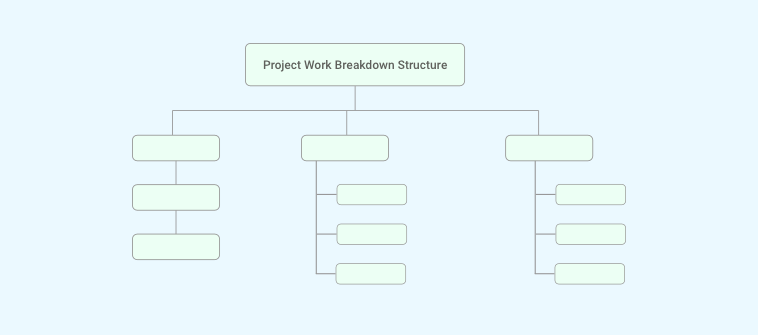You’re about to make a crucial decision for your project. One that could either make it a huge success or a complete failure. How do you feel in this situation?
If you’re like most project managers, you probably feel anxious, stressed, and overwhelmed. You know that every decision you make impacts your project’s outcome significantly. You want to choose the best option but don’t have much time, resources, or information.
This is the reality of decision-making in project management. It’s one of the vital and challenging skills you need to master as a project manager. Whether it’s about picking the right strategy, allocating resources, resolving conflicts, or assessing risks, you have to make decisions that satisfy your stakeholders and align with your goals.
But how do you make effective decisions in project management? How do you balance speed, quality, and stakeholder satisfaction? How do you avoid common mistakes and biases that can cloud your judgment?
The answer is simple: you need a systematic and strategic approach to decision-making.
In this blog, we’re going to show you what decision-making in project management is, why it matters, how to do it right, and what to watch out for. By the end of this blog, you’ll be able to make better decisions for your projects and achieve greater results.
What Is Decision-Making in Project Management?
Decision-making in project management is a dynamic process critical for project success. It involves evaluating alternatives, weighing risks, and making informed choices that steer the project in the right direction.
Effective decision-making empowers project managers to navigate uncertainties, allocate resources efficiently, and overcome challenges head-on.
As a project manager, you need to combine analytical thinking with strategic foresight to make decisions that positively impact your project’s outcome and stakeholder satisfaction. So you have to gather relevant information systematically, select the best approach, use data-driven insights, and implement and monitor your decisions in real time. By doing this, you boost your team and project performance and achieve success with the right decisions!
Now let’s dig deeper into why decision-making is essential in project management.
Read More: What is IT Project Management? [Complete Guide for 2024]
Importance of Effective Decision-Making in Project Management
Let’s look at the importance of decision-making in project management.
- Manages risks & obstacles: By making effective decisions, project managers can identify potential risks, evaluate alternatives, and choose the best course of action. This enables them to mitigate risks and overcome obstacles throughout the project lifecycle.
- Optimizes resource allocation: By making well-informed decisions, project managers can allocate resources strategically, ensuring that the right resources are assigned to the right tasks at the right time. This helps in optimizing efficiency and minimizing resource wastage.
- Enhances efficiency & productivity: Sound decision-making eliminates unnecessary steps, and prioritizes tasks. This results in improved efficiency, increased productivity, and timely project completion.
- Aligns with organizational goals: Effective decision-making helps project managers to align their project efforts with the organization’s goals and objectives. As a result, they can create consistency and coherence across projects and boost organizational performance.
- Fosters continuous innovation: Making informed decisions encourages innovative thinking, creative problem-solving, and collaboration within the project team, creating an environment that nurtures new ideas and drives continuous improvement.
- Drives growth & exceptional results: The ability to make well-informed decisions in project management is instrumental in driving project growth and maintaining a competitive edge in today’s business landscape.
You know the importance of decision-making now, but what are the key factors that influence the decision-making process in project management?
Key Factors Influencing Decision-Making in Project Management

You need to make effective decisions to manage projects successfully. But it’s not easy. You have to deal with many factors that affect your choices.
So let’s explore the five key factors that significantly impact decision-making in project management.
1. Project Goals & Objectives
Clear and well-defined project goals and objectives serve as the foundation for decision-making. Every decision should align with the overarching project goals to ensure the project stays on track. Understanding the desired outcomes and deliverables will help you make informed decisions to drive the project toward success.
Read More: Why Differentiate Between Project Goals and Objectives?
2. Stakeholder Expectations & Requirements
Stakeholders are indispensable contributors to every project. As a project manager, you should carefully consider their expectations and needs during decision-making. You must engage with stakeholders actively and understand their perspectives. This helps satisfy their interests and maintain their support while fostering positive relationships.
3. Time & Resource Constraints
Project management operates within the confines of time and resources. Decisions made in this context should factor in the project timeline and available resources. As a project manager, you must balance meeting project deadlines and optimizing resource allocation. By prioritizing tasks and allocating resources efficiently, you can make decisions that keep the project on schedule and within budget.
Read More: Resource Planning for Multiple Projects: A Guide for 2024
4. Risk Assessment & Management
Every project entails inherent risks, and effective decision-making requires a thorough assessment and management. It’s a good idea to identify potential risks, evaluate their impact, and devise mitigation strategies. You should consider the level of risk tolerance and prioritize actions that minimize or eliminate potential risks. Proactively addressing risks can help you make decisions that safeguard project success.
Read More: How to Overcome Risks Using a Comprehensive Risk Management Plan
5. Organizational Culture & Policies
The organizational culture and policies within which a project operates also influence decision-making. Project managers must consider their organization’s values, norms, and established procedures. Project managers promote consistency and compliance by aligning their decisions with the organizational culture and policies, ensuring the project’s integration with the larger organizational framework.
Standard Techniques of Decision-Making in Project Management
Let’s explore the various decision-making techniques in project management that you can employ to make informed and effective decisions.
1. Rational Decision-Making
Rational decision-making follows a logical and systematic approach. It involves identifying the problem, gathering relevant information, and generating alternatives. Once this is done, you then evaluate the alternatives based on predetermined criteria and select the best option. This technique ensures that decisions are based on objective analysis and logical reasoning, leading to optimal outcomes.
2. Intuitive Decision-Making
Intuitive decision-making relies on the project manager’s instincts, experience, and tacit knowledge. Here, a project manager taps into past experiences and uses gut feelings to make decisions quickly. While it may seem subjective, intuitive decision-making can be valuable when faced with time constraints or limited data. The technique leverages the project manager’s expertise to make effective choices.
3. Data-Driven Decision-Making
The next technique for the decision-making process in project management is data-driven decision-making. It involves using relevant and reliable data to make informed decisions. You collect and analyze data to gain insights, identify patterns, and make decisions based on empirical evidence. For this, you can use a tool that collates and categorizes data, helping you make informed choices that are objective and grounded in factual information.
4. Consensus-Based Decision-Making
Consensus-based decision-making involves gathering input and perspectives from various stakeholders to reach a mutually agreed-upon decision. This technique promotes collaboration, inclusivity, and collective ownership of decisions. Project managers can leverage the group’s collective wisdom to make well-rounded decisions by involving team members, stakeholders, and subject matter experts.
5. Cost-Benefit Analysis
The cost-benefit analysis technique helps project managers evaluate potential costs and benefits for different alternatives. You quantify and compare the expected benefits against the associated costs. This way, you can assess the feasibility and desirability of different options. This technique enables you to make decisions that maximize value while considering resource constraints.
6. Decision Trees & Decision Matrices
Decision trees and decision matrices are visual tools that aid in complex decision-making. Decision tree map out different decision paths and their potential outcomes, allowing you to evaluate the consequences of each choice. Decision matrices provide a structured framework for evaluating multiple alternatives against specific criteria, facilitating systematic and objective decision-making.
So these were the critical decision-making techniques in project management. Now, it’s time to delve into the process of decision-making.
Read More: change management in project management
Master the Decision-Making Process: Key Steps for Effective Results

The decision-making process in project management involves a series of systematic steps that ensure informed and effective choices.
Let’s break down the steps and discuss them.
Identify the Key Decision at Hand
The first step in the decision-making process is to identify the decision you want to make. The process involves understanding the problem or opportunity at hand and defining the desired outcome.
For instance, you have to decide how to use your resources wisely, such as money, people, and tools, for different project tasks or teams. You also have to make decisions about project schedules, task order, and critical path analysis to make sure your project moves smoothly and finishes on time.
Gather & Analyze Relevant Information
Once you identify the decision to make, you must gather and analyze relevant information. This includes collecting data, conducting research, consulting stakeholders, and considering internal and external factors influencing the decision.
Note that decision-making tools are designed to alleviate the burden of tedious tasks, enabling you to extract crucial information efficiently without getting caught up in unnecessary data collection and compilation.
Using a tool, you can dive into data analysis using presentation-ready reports, accelerating the decision-making process significantly. For instance, look at the example of a Summary report in ProProfs Project.
This comprehensive report provides detailed information on task statuses, departmental assignments, and overall project progress, offering a clear perspective on the project’s current state.
Without a tool to analyze such data, you would need to manually identify the number of active, on-hold, and inactive tasks. Additionally, you would have to separately determine the department(s) lagging in progress and calculate the overall project progress. This approach would be both time-consuming and tedious.
The smarter alternative? Embrace a modern project management tool!
Generate & Evaluate Alternative Solutions
The next step is to generate various alternative solutions or options. This involves brainstorming ideas and considering different approaches to address the identified decision.
Then, to evaluate the alternatives, assess their advantages, disadvantages, feasibility, and alignment with project goals. This assessment allows you to narrow down the options to select the most viable ones.
For instance, when delegating resources across multiple projects, you may consider project priorities, resource availability, and team expertise to determine the most optimal allocation strategy.
Make & Implement the Decision
Once the alternatives are evaluated, it’s time to make the final decision. This involves selecting the best option based on the analysis conducted in the previous steps. The decision should align with project goals, stakeholder expectations, and the available resources.
After making the decision, project managers move on to implementing it. This involves creating a plan, allocating resources, and communicating the decision to relevant stakeholders.
For example, you may decide to distribute the budget based on the importance of each project, ensuring resources are allocated strategically. Similarly, you might assign resources based on team members’ expertise for specific projects, maximizing efficiency and leveraging their skills effectively.
Monitor & Evaluate the Decision’s Outcomes
The final step in the decision-making process is to monitor and evaluate the outcomes. This step entails keeping a close eye on the progress made, measuring performance against predetermined metrics, and assessing whether the decision yields the desired results.
Through this evaluation, valuable insights can be gained, enabling the identification of any necessary adjustments or corrective actions.
A project manager can diligently monitor the allocation of resources and budget, ensuring the efficient execution of the project and optimizing logistics to achieve a successful outcome with a significant impact.
Following these steps can help you navigate the complexities of decision-making and drive successful project outcomes effortlessly.
The decision-making process in project management is not without its share of inevitable challenges.
Unraveling Common Challenges & Pitfalls in Decision-Making

Let’s explore the five common challenges and pitfalls that project managers face during the decision-making process.
Cognitive Biases
Cognitive biases are inherent mental shortcuts or patterns that can cloud judgment and lead to irrational decision-making.
Examples include confirmation bias, where individuals favor information that confirms their existing beliefs, or availability bias, where the ease of recalling information influences decision-making.
Project managers must be aware of these biases and actively work to mitigate their impact. By seeking diverse perspectives, considering alternative viewpoints, and challenging assumptions, project managers can minimize the negative effects of cognitive biases.
Analysis Paralysis
Analysis paralysis occurs when project managers become overwhelmed with an excess of information or options, leading to indecisiveness or delayed decision-making.
While thorough analysis is essential, spending too much time in the analysis phase can hinder progress and timely decision-making. To overcome analysis paralysis, project managers can set clear decision-making criteria, establish reasonable deadlines, and prioritize key factors. It’s crucial to balance gathering sufficient information and making a timely decision to keep the project on track.
Conflicting Information & Opinions
Project managers often encounter conflicting information and opinions from stakeholders or team members. This can create uncertainty and make decision-making challenging.
To address this challenge, you should encourage open communication, actively listen to different perspectives, and seek a common understanding. Respecting diverse viewpoints helps navigate conflicting information and opinions and make decisions incorporating the best available insights.
Resistance to Change
Resistance to change can hinder decision-making when team members resist adopting new approaches or ideas.
To combat such challenges, you should encourage open dialogue, promote constructive dissent, and empower team members to challenge the status quo. This will help you embrace diverse thinking and welcome innovation, leading to project success.
Read More: Change Management in Project Management: An Ultimate Guide
Decision-Making Fatigue
Decision-making fatigue refers to the declining quality of decisions due to mental exhaustion or overload.
As project managers face numerous decisions throughout a project’s lifecycle, decision fatigue can compromise judgment and result in subpar outcomes.
To avoid this, you can prioritize and delegate decisions when possible, take regular breaks, and engage in activities that promote mental well-being. Remember, you can maintain your decision-making effectiveness by recognizing the signs of fatigue and taking proactive steps to manage it.
So which practices can help us avoid these challenges and lead us on the right path?
Let’s take a look at some proven best practices for improved decision-making.
Best Practices for Effective Decision-Making
Here are the best practices for effective decision-making.
Create a Decision-Making Framework or Model
A decision-making framework provides a structured approach to guide the decision-making process. It outlines the steps, criteria, and considerations for making informed choices.
Creating a framework helps ensure consistency and objectivity in decision-making.
As a project manager, your first step is identifying the decision, then gathering relevant information from various sources. Also, evaluating alternative options based on predefined criteria helps assess feasibility and impact on stakeholders.
Finally, selecting the best option that aligns with project goals and predefined benchmarks ensures effective decision-making.
Involve the Right Stakeholders
Engaging the right stakeholders is crucial for effective decision-making.
Stakeholders possess valuable insights, expertise, and perspectives that can contribute to better decision outcomes. Identifying and involving stakeholders with a vested interest or expertise related to the decision is essential.
For instance, when deciding on a software tool, involving representatives from the IT department, end-users, and key project sponsors ensures a comprehensive understanding of requirements and considerations.
Seek Diverse Perspectives & Input
Diversity of perspectives enhances the quality of decision-making.
Project managers should seek input from individuals with different backgrounds, experiences, and expertise. By incorporating diverse viewpoints, you can minimize blindspots and better understand the decision’s implications.
So soliciting input from team members, subject matter experts, and external consultants can provide broader insights and possibilities.
Encourage Open Communication & Collaboration
As a project manager, it is crucial for you to foster an environment where your team members feel empowered to share their ideas, concerns, and opinions openly. This includes creating a culture where feedback is welcomed, encouraging healthy debates, and promoting active listening.
When you foster an environment that values open communication and collaboration, you can tap into the team’s collective intelligence and improve decision-making outcomes.
Read More: 10 Surefire Ways to Improve Team Communication
Leverage Tools to Support Decision-Making
Leveraging tools and technology can significantly enhance data-driven decision-making in project management.
Various software applications, data analytics tools, and project management platforms provide valuable data analysis, data visualization, and collaboration functionalities.
For instance, using project management software features that integrates decision-making, such as reports and data-rich dashboards, can aid in evaluating work and adjusting workflows where necessary. These decision-making tools in marketing project management enable project managers to organize information, streamline collaboration, and easily make data-driven decisions.
Watch this quick video to learn more about why you use a simple project management tool to support your decision-making process.
Turbocharge Your Decision-Making for Success!
Embracing effective decision-making practices in project management is the key to steering your projects toward consistent success. Remember, your choices profoundly impact the outcome of your project and the satisfaction of your stakeholders.
To make informed decisions, equip yourself with the right tools and leverage data-driven insights. Foster open communication within your team, enabling collaboration and collective wisdom!
By embracing the complexities of decision-making in project management and data-driven approaches; you can conquer challenges and unlock the full potential of your projects!
Frequently Asked Questions
Q1: How Can I Make My Project Better?
There are several ways by which you can make your project better. Take a look:
- Consider ways to expand perceptibility and cognizance
- Establish a day-to-day routine for your team
- Stay far from unnecessarily complicating your projects
- Put in place appropriate expectations and stick to them
- Share changes to your team
Q2: What Are The 3 Types of Decision Making?
The 3 types of decision making are:
- Extensive decision-making process
- Limited decision-making process
- Routine decision-making process
Alternatively, you also list them as:
- Consumer decision making
- Business decision making
- Personal decision making
Q3: What Is an Example of Decision Making?
Decision making is required in every aspect of running a business. For example, identifying problems in the production process, finding loopholes before launching a product, understanding the effect of increasing store opening hours are all good examples of instances where decision making is required.
FREE. All Features. FOREVER!
Try our Forever FREE account with all premium features!





